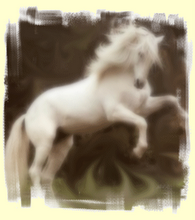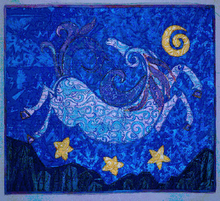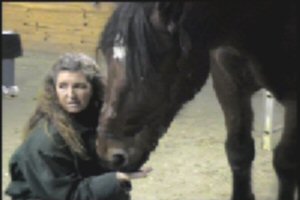An answer to a post concerning "bargy" horse:
Here's a bit of a hint - its always the "low men on the totem pole" who physically fight for position in the herd. In other words, the leaders will "assume" the position just by their demeanors and the other horses will "choose" that horse for his/her leader. As long as we puny humans continue to "fight" with the horse we place ourselves low, low, low in the hierarchial ranks of the herd. Not where we want to be cause that's where we get hurt. The horse is being bargy because he's learned he CAN be ... that he is higher ranking and he doesn't HAVE to be respectful. It's not about the whip or the bat or the chain or the halter - its about the demeanor and the attitude. BE the lead horse. BE higher ranking. Make yourself BIG and say to him "exCUSE ME! I do NOT like to be pushed around!" and then work on his hind-end a bit (hind end disengagments) until he's soft and compliant with his head down a bit and he's BLINKING ... and, possibly chewing. Then let him relax, think on things for a moment or two and return him to where you first started. Then, assertively ask him to walk WITH you politely. No can do? He's barging again? Repeat the same scenario above. Absolutely NO fighting with him. No shanking, no aggressive attitude or actions ... as the Dog Whisperer would say ..."Calm Assertiveness". If he barges through you again let him run into the end of the rope and stand firm so he'll HAVE to swing his hindend around to face you. Then work your hind end disengagements again. Wait, once again, for the blinking and the head lowering. Then calmly go back to where you started once again and say, "Come on, we'll try this again." Ask him to FOLLOW you back to your original start place. If he gets too close on your heels GET BIG AGAIN and say exCUSE ME! You are TOO CLOSE! and back him up with ASSERTIVENESS; not aggressiveness. Let him think on it for a few then repeat request. It is YOUR ATTITUDE that is going to change his thinking. Not your physical prowess. That does diddly-squat except to challenge him to furher fighting with you. BE his leader. BE assertive. BE calm. BE expectant that he IS going to move and respect you. Take as long as it takes and always approach him with the assertive, leader attitude. Then ... have fun teaching this to his owner! It's not about the horse! --Gwen
Subscribe to:
Post Comments (Atom)



1 comment:
Continuation:
"Oh boy can I relate to this thread. My horse is STUBBORN!
What would you do if you asked him to back, and he just raised his head and stood still? A whack across the chest with a bat and a loud "BACK!"?
Also, even when I ask my horse to (while I'm on the ground) walk on or take a step to the side, I get such a delayed reaction. Do I just have to ask HARDER?"
REPLY:
Well, one always wants to start the request with the lightest amt. of pressure possible. This is merely a "glance" their way to ask them to move. If no response then up the pressure small increments at a time until you get a response. As soon as they "try" to back (this means even a lean back with no hoof action) then release your pressure instantly and reward. A nice scritch in a favorite place or even a Cheerio or piece of grain. Repeat, starting with the "glance". Be patient but be assertive. EXPECT your horse to move back when you ask! In other words, don't ask him to step back while you're thinking, "Yeah, RIGHT! Like THIS is going to work!!!" *grin* ... Ask him to step back EXPECTING him to respond. Just changing your thinking is going to change the energy your horse is receiving from you and if he feels your energy going out with INTENT and with "OK, you will back up NOW!" thought, then he will read that and 'hear' that much stronger and more loudly than a crack on the chest or whatever done in frustration. Horses are designed to take in and "read" the energies around them as part of their survival system. This is how they "communicate" with one another. Ever notice how when the lead or the alpha mare merely glances at another horse that is too close and that horse will reel away? If not, what does she do? She'll swing her head around with her ears back (next increase of pressure) and then, if they don't listen she'll reel around, herself, to physically "bite" the offender. But the bite rarely does any harm. So think in terms of increasing your pressure that way. And, as soon as the "offender" has complied, the INSTANT of compliance, RELEASE the pressure and reward! There's no force that way, no "punishment" for the horse simply being a horse and energy and INTENT speak a whole lot louder than our voices and even our body language!
This may sound "hokey" to some but I have rarely had a horse not respond, nor have my students, when the human's INTENT is in the "right place". THINK assertively .. you ARE bigger than the horse *grin* ... FEEL assertive instead of frustrated and aggressive ... EXPECT the horse to comply simply because you *are* his "leader" and be patient. Think in terms of "teaching" your horse instead of "training" or "making" your horse do/learn something.
In extremely tough situations I may swat the horse on the chest (if I'm asking for a back up) with a bat or crop and I'll MEAN it (and the horse KNOWS I mean it just like he would a "bite" from his mare) but I won't do it with frustration or anger ... but will use this simply as the highest "pressure" that I feel might be needed for that individual horse and usually never have to use it again. Again, remember, physical hitting, swatting, smacking, shoving, pushing, or whatever, only invites the horse to return the favor somehow and play "the game" OR will make the horse fearful of you at which point nothing is gained and much is lost. :) -- Gwen
Post a Comment